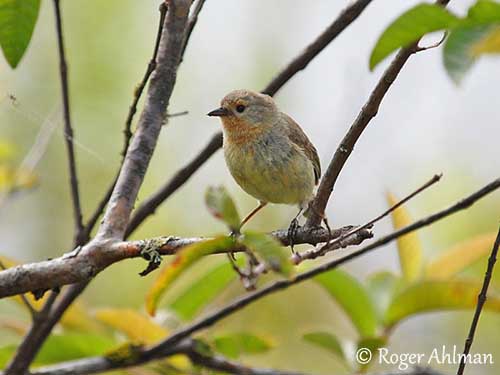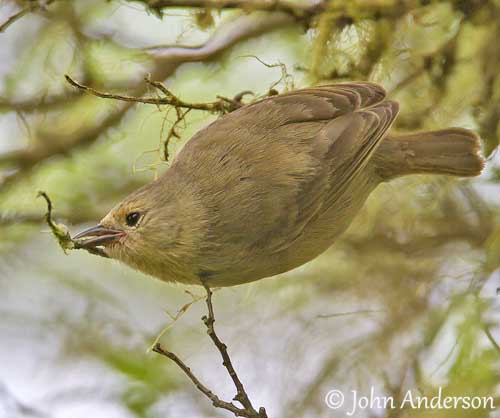
Fr: Géospize olive
All: Waldsänger-Darwinfink
Esp: Pinzón de Darwin Oliváceo
Ita: Fringuello cantore delle Galapagos
Nd: Olijfboszangervink
Sd: Drillfink
Photographers:
Roger Ahlman
Pbase Galleries Peru and Ecuador
John Anderson
John Anderson Photo Galleries
Text by Nicole Bouglouan
Sources:
HANDBOOK OF THE BIRDS OF THE WORLD Vol 16 by Josep del Hoyo- Andrew Elliot-David Christie – Lynx Edicions – ISBN: 9788496553781
BirdLife International (BirdLife International)
Wikipedia, the free encyclopaedia
Green Warbler-Finch
Certhidea olivacea
Passeriformes Order – Thraupidae Family
Darwin’s Finches - Generalities
INTRODUCTION:
The Green Warbler-Finch is closely related to the Grey Warbler-Finch, but they differ in appearance, song, range and habitat.
This species collected by Charles Darwin in 1835 was first identified as wren or warbler. But in March 1837, the ornithologist John Gould informed him that this small bird was included in the Darwin’s Finches. It is endemic to the Galapagos Islands.
DESCRIPTION OF THE BIRD:
Biometrics:
Length: 10 cm
Weight: 8-12 g
The adult male has sandy-brown upperparts and greyer head. The upperwing and the short tail are brownish.
The underparts are variable, usually white with warm buff on flanks.
The head is greyer than the upperparts, with pale supercilium and foreface.
The parulid-like bill is thin, long and pointed, blackish when breeding, and dull orange-yellow with dark culmen outside this period. The eyes are dark brown. Legs and feet are blackish.
The female resembles male but she has olive-brown head and upperparts. The upperwing is sandy-brown with two indistinct wingbars. The underparts are white with pale buff wash on breast and flanks.
The juvenile is similar to the adult female.
However, some birds show chestnut throat and breast, or only restricted to the mid-throat. Others may have chestnut lores too. These differences could be related to the age.

RANGE:
The Green Warbler-Finch is found on several Galapagos Islands such as Fernandina, Isabela, Santiago, Rábida, Pinzón, Baltra and Santa Cruz.
HABITAT:
The Green Warbler-Finch is most common in humid highland forest of Scalesia pedunculata, usually between 300 and 700 metres of elevation. It can be found too in dry lowlands, but probably only seasonally and in low abundance.
CALLS AND SONGS: SOUNDS BY XENO-CANTO
The Green Warbler-Finch sings from perches in trees or low bushes. Its song is shorter than that of the Grey Warbler-Finch, with less repeated notes.
The high-pitched song includes buzzes ‘piut-tze zzzzzzzzzztip” during two seconds. It also utters a shorter phrase “chzp-zee-chip” or “zhh-chip zhh-chip”.
These sounds are closely related to the small size of the bill.
BEHAVIOUR IN THE WILD:
The Green Warbler-Finch’s thin bill indicates an insect-eater. It feeds on small insects and spiders.
It may catch preys on the wing, but also probes among the vegetation, moss, leaves and bark, to extract invertebrates.
It can be seen alone or in loose mixed groups, usually with other finches.

The Green Warbler-Finch is monogamous. It usually breeds during the hot wet season, when the preys are abundant. The pairs may have long-term pair-bonds, and they maintain and defend a small territory.
The Green Warbler-Finch is resident in its range. It probably performs some seasonal movements.
This species has an agile flight when catching insects on the wing.
REPRODUCTION OF THIS SPECIES:
The breeding season occurs during the hot wet season, related to food resources.
The male builds a spherical nest with lateral entrance. It is made with dry grasses, moss and lichens. It is placed in small branches.
The female lays 4 whitish eggs with darker spots. She incubates alone during 12 days. The young birds fledge about two weeks after hatching.
PROTECTION / THREATS / STATUS:
The Green Warbler-Finch is common and widespread throughout its range. It is vulnerable to human activities and degradation of its habitat. But currently, this species is not globally threatened.